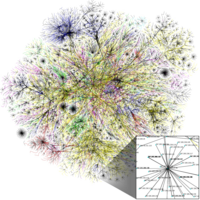
Photo from wikipedia
Solar insecticidal lamps Internet of Things (SIL-IoT) is a new green prevention and control technology for pest management. In the implementation of SIL-IoT to large-scale regions, two practical issues remain… Click to show full abstract
Solar insecticidal lamps Internet of Things (SIL-IoT) is a new green prevention and control technology for pest management. In the implementation of SIL-IoT to large-scale regions, two practical issues remain to be solved, that is: 1) scheduling the cleaning tasks of SILs periodically and 2) minimizing the insecticidal efficiency reduction over time. As smartphones are widely available among farmers across the globe, mobile crowdsensing (MCS) for agricultural data collection becomes a cost-effective and efficient solution by integrating participatory sensing based on a large group of individuals. This article proposes an MCS-enabled framework to address the SIL maintenance problem (SILMP) and perform system analysis by considering both the partition structure of farmland and the insecticidal efficiency of SILs. In addition, considering the farmland’s practical natural geographical features, we propose dividing the regions of interest into numerous subareas, where each subarea can be considered a separate partition. Finally, we formulate the SILMP framework as two subproblems, i.e., path planning and task selection, and propose two different methods to tackle each problem based on the concept of greedy algorithm. Simulation results show that our proposed methods have improved performance in the tradeoff between task cost and insecticidal efficiency and outperform the three selected baseline algorithms.
Journal Title: IEEE Internet of Things Journal
Year Published: 2022
Link to full text (if available)
Share on Social Media: Sign Up to like & get
recommendations!